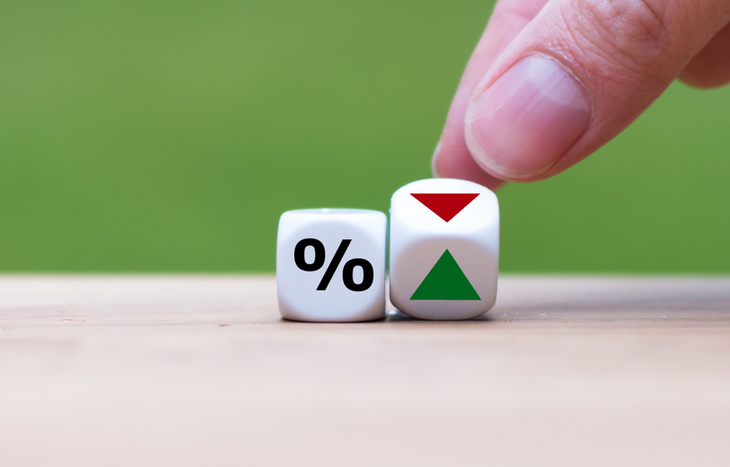What Are Interest Rates?
Any time you invest money, you’ll find yourself dealing with interest rates. They can be a little confusing if you’re just getting started. What are interest rates, and how do they work? It’s a question worth asking, and the answer depends strongly on the financial product you’re talking about. In the case of investments, the higher the rate, the better. In the case of debt – such as a bank loan – a lower rate is more advantageous. Context is important for understanding how to capitalize on or protect yourself from interest rates.
Here’s a surface-level look at interest rates to help you get you familiar with the concept. The more you understand them, the easier it will be to make interest rates work for you. Whether you’re getting ready to invest in a financial product or need to take out a loan, it’s vital to understand the interest involved.

Interest Rate Definition
An interest rate is the premium paid to borrow money. More specifically, it’s defined as “the amount of interest due per period, as a proportion of the amount borrowed.” As with most financial terms, it’s best understood through an example.
Gerard decides to invest in municipal bonds. He buys $10,000 in Treasury bonds at a 2.15% yield rate. This means that he’ll earn 2.15% of $10,000 on his investment. He’ll collect these profits when he claims the bond after its 20-year term.
The above example is from a creditor’s perspective. Gerard lends the government his money and the government owes him interest. From a debtor’s perspective, interest works in reverse.
Malcom buys a rental property. His mortgage is $250,000 at a 30-year fixed rate of 3.25%. On top of principal repayment, Malcom will pay an additional 3.25% for the privilege of borrowing the funds to cover the purchase. The interest payment will show up on his monthly mortgage statement.
The entity lending the money institutes an interest rate as a way to make money. An interest rate is effectively what turns lending into an investment because it guarantees ROI on the loan.
Interest Rate Formula
There are many different formulas for calculating interest and its effect on a principal balance. The most basic is: I = Prt, where…
- I = total interest value
- P = principal value
- r = interest rate
- t = time period (years).
Multiplying the principal value by the interest rate and then by the time period gives you a total value of accumulated interest. This is useful for fixed instances, such as amortizing your mortgage or calculating the ROI of a bond.
It’s important to realize that this formula is for simple interest. Simple interest is different from compounding interest in that the principal remains static. If you’re trying to figure out the sum of continued reinvestment over time, compound interest is a better measure. Check out our compound interest calculator to see compound interest at work over time.
How Does Compound Interest Work?
On the surface, an interest rate is a percentage of the principal that’s paid back on top of the principal amount. But what happens when the investment is long-term or continually reinvested? If your money continues to work for you, you’ll experience the power of compound interest. The rate may stay the same, but the opportunities for wealth increase at an exponential pace.
Compound interest investments continue to add interest payments to the principal balance, which increases the earning power of that balance. If you earn 10% on $1,000, your total is $1,100. If you invest this again at the same 10%, you’ll earn $110 instead of the original $100, bringing your total to $2,210. The pattern continues on and on, growing stronger and stronger as the balance grows. All the while, the interest rate remains the same.
This isn’t to say interest rates can’t change. In fact, they frequently do. It’s unlikely that a compounding investment will return the same percentage year over year. In these situations, investors need to look at compound annual growth rate (CAGR).
Where Do They Come From?
It’s clear that interest rates have a major impact on your earning potential and investment power. So… who determines them?
These rates come from central banks and are used across the investing realm as part of open market operations (OMO). These rates help modulate supply and demand for loans and credit. For example, if interest rates are high for loans, public companies may choose to issue new stock equity, which drives demand. Conversely, low interest rates might drive more investment in real estate, since borrowing is easier.
The world of interest rates is extremely complex. The bottom line investors need to know is that interest rates govern every financial product out there. There’s a cost to borrow money and an advantage to lending it. That’s how investing works.
How to Make the Most of Interest Rates
Making the most of interest rates depends on which side you’re on. If you’re benefiting from compound interest in an investment, time invested and continued reinvestment are important. These variables will expedite your ROI. If you’re borrowing money, you want to keep the interest rate as low as possible. You can often do this by proving that you’re a reliable borrower and shopping around for low rates.
This is why it’s so important to expand your knowledge of financing and investing alike. Sign up for the Investment U e-letter below to get unique financial insights each and every day.
What are interest rates? Depending on which side you’re on, they can either be a wealth building tool or a wealth draining variable. Interest makes investments more lucrative and debt more crushing. In either case, they work the same: by compounding a lump sum. To make interest work for you, you’ll need to put yourself in a position to either drive it down or bring it up. Either way, interest is worth paying attention to.





